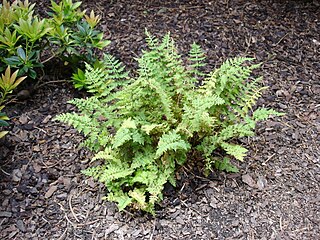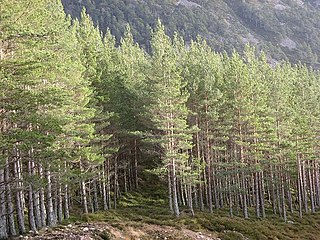
The Cairngorms are a mountain range in the eastern Highlands of Scotland closely associated with the mountain Cairn Gorm. The Cairngorms became part of Scotland's second national park on 1 September 2003. Although the Cairngorms give their name to, and are at the heart of, the Cairngorms National Park, they only form one part of the national park, alongside other hill ranges such as the Angus Glens and the Monadhliath, and lower areas like Strathspey.

The Caledonian Forest is the ancient (old-growth) temperate forest of Scotland. The forest today is a reduced-extent version of the pre-human-settlement forest, existing in several dozen remnant areas.
Calcifugous grasslands and montane communities are botanical groupings in the British National Vegetation Classification system.

Athyrium filix-femina, the lady fern or common lady-fern, is a large, feathery species of fern native to temperate Asia, Europe, North Africa, Canada and the USA. It is often abundant in damp, shady woodland environments and is often grown for decoration.

Athyrium (lady-fern) is a genus of about 180 species of terrestrial ferns, with a cosmopolitan distribution. It is placed in the family Athyriaceae, in the order Polypodiales. Its genus name is from Greek a- ('without') and Latinized Greek thyreos ('shield'), describing its inconspicuous indusium . The common name "lady fern" refers in particular to the common lady fern, Athyrium filix-femina.

Athyrium niponicum, the Japanese painted fern, is a species of fern native to eastern Asia.

The flora of Scotland is an assemblage of native plant species including over 1,600 vascular plants, more than 1,500 lichens and nearly 1,000 bryophytes. The total number of vascular species is low by world standards but lichens and bryophytes are abundant and the latter form a population of global importance. Various populations of rare fern exist, although the impact of 19th-century collectors threatened the existence of several species. The flora is generally typical of the north-west European part of the Palearctic realm and prominent features of the Scottish flora include boreal Caledonian forest, heather moorland and coastal machair. In addition to the native species of vascular plants there are numerous non-native introductions, now believed to make up some 43% of the species in the country.
Marsupella arctica, commonly known as Arctic rustwort, is a species of liverwort found in the Northern Hemisphere. It is present in Alaska and Greenland and has a European distribution confined to Scotland and Svalbard. The Scottish population was first discovered in 1989 and is restricted to two sites in the Cairngorm mountains - the Lairig Ghru and Beinn a' Bhùird.
Hygrohypnum styriacum, commonly known as snow brook-moss or hygrohypnum moss is a species of moss found in the Northern Hemisphere.

Andreaea frigida, commonly known as icy rockmoss, is a moss endemic to Europe which is found in mountainous regions in Austria, the Czech Republic, France, Germany, Hungary, Italy, Norway, Romania, Poland, and Spain. In the UK its occurrence is widespread in the Cairngorms National Park, where it is typically found on rocks in burns fed by snow patches, but it is not found elsewhere except at a single site in the Lake District of England.

Athyrium distentifolium commonly known as alpine lady-fern is a fern found in widely in the Northern Hemisphere.

Cystopteris dickieana, commonly known as Dickie's bladder-fern, is a fern with a wide distribution in the Northern Hemisphere. There is debate amongst botanists as to whether it is a species in its own right or a variant of C. fragilis.
Jamesiella scotica is a species of lichen thought to be endemic to the United Kingdom and Ireland. In the UK, it occurs in montane habitats in England, Wales and Scotland at heights of over 200 metres, thriving on decomposing bryophytes on base-rich soils.

Long-lying snow patches in Scotland have been noted from at least the 18th century, with snow patches on Ben Nevis being observed well into summer and autumn. Indeed, the summit observatory, which operated from 1883 to 1904, reported that snow survived on the north-east cliffs through more years than it vanished.

Athyrium asplenioides, or southern lady fern, is a species of the family Athyriaceae. It is a deciduous fern and reaches a height between 1 and 3 feet

Athyrium angustum, the northern lady fern, is a fern native to northeastern North America. It was long included in the superspecies Athyrium filix-femina, but is now largely recognized as a distinct species.

Central Europe contains several life zones, depending on location and elevation.

Athyrium otophorum, the eared lady fern, is a species of fern in the family Athyriaceae, native to Japan and east Asia. It is deciduous and grows in a tufted oval formation to 50 centimetres (20 in) tall and wide. The triangular fronds open pale green before turning grey-green with maroon stems. Hardy down to −10 °C (14 °F) it is suitable for cultivation in any moist, partially-shaded spot with good drainage.

Invereshie and Inshriach is a national nature reserve on the western flank of the Cairngorms in the Highland council area of Scotland. The reserve covers habitats at a range of different altitudes, ranging from Caledonian Forest beside the River Feshie in the west, via bog and open moorland, to an arctic-alpine environment on the Cairngorm plateau. The Munro summit of Sgòr Gaoith (1118 m) lies on the eastern boundary of the reserve. The forested areas of the reserve form part of an expanse of Caledonian pinewood that stretches from Glen Feshie to Abernethy, and which as a whole forms the largest single area of this habitat remaining in Scotland. The reserve is owned and managed jointly by NatureScot and Forestry and Land Scotland (FLS): NatureScot own the Invereshie portion of the reserve and FLS the Inshriach area.

The Uapishka Biodiversity Reserve is a protected area in the Côte-Nord region of Quebec. It is one of five biodiversity reserves in the province. It is to the east of the Manicouagan Reservoir and includes a large part of the Monts Groulx. It is also part of the central area of the Manicouagan Uapishka Biosphere Reserve.














